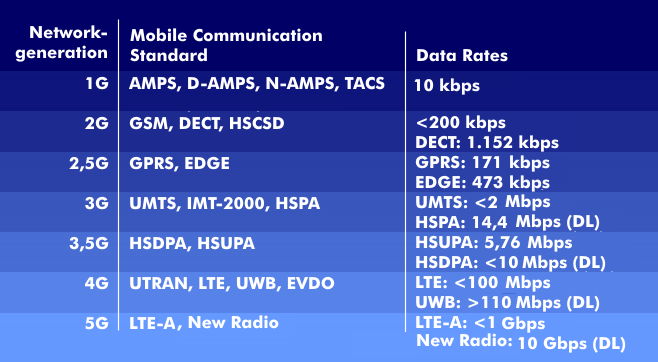fourth generation (mobile communications) (4G)
Following the introduction of the 3G mobile communications systems, which are essentially characterized by UMTS, the 4th generation (4G) systems were designed and specified under IMT-Advanced by the International Telecommunication Union( ITU). They are under the target projection of "Always best connected," "Beyond 3G," and Mobile Broadband.
4G systems will provide end users with bandwidths of up to 1 Gbit/s at short range and up to 100 Mbit/s at long range, as well as improved performance. Fourth-generation systems are based on a core network and a common IP-basedplatform for media access. 4G networks are all-IP, low- latency, flat- architecture networks that support mobile broadband with high-speed access to the Internet. The network architectures are optimized for data packet switching, use Orthogonal Frequency Division Multiple Access( OFDMA) as the radio interface to ensure high speeds and many users per radio cell, and Multiple Input Multiple Output( MIMO) to improve reception conditions.
4th generation mobile communications systems operate in the 800 MHz, 1.8 GHz and between 2 GHz and 6 GHz frequency ranges. The 800 MHz range is used for upstreams and downstreams. In the latter frequency range, WLANs transmit according to 802.11n, Broadband Wireless Access( BWA) according to 802.16m, Mobile WiMAX, Ultra Mobile Broadband( UWB), High Capacity - Spatial Division Multiple Access ( HC- SDMA), iBurst, Evolution Data Optimized( EVDO) and Long Term Evolution( LTE).
4G cellular systems operate via horizontal and vertical handover, which means across systems and layers. The aim of 4G activities is to offer all users worldwide the full range of services across networks.
The 4G activities are being driven by the world's largest mobile operators under the name Next Generation Mobile Network( NGMN). Founding members of the NGMN initiative include T-Mobile, Vodafone, Orange, China Mobile, KPN and NTT DoCoMo.
Further development of Long Term Evolution (LTE) has resulted in Long Term Evolution Advanced(LTE-A). With data rates of 1 Gbit/s, this mobile communications technology has been assigned to the higher mobile communications generation 5G with New Radio.

